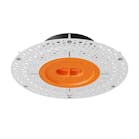Sedna Lighting survey finds consumer awareness low regarding energy consumption of holiday lighting
Dec. 15, 2014
In the past decade homeowners and bill-payers have adopted numerous energy saving measures in an attempt to reduce carbon footprint and utility bills, such as smart meters, cavity wall insulation and energy efficient bulbs.
A GoCompare study reckons the average British home consumes an alarming 22.8 days’ worth of electricity on Christmas lighting alone over the festive period, but we haven’t seen the same rush to employ efficient measures with upgrades to LED as we have around the rest of the home. With the expense of Christmas it’s easy to pass on the idea of higher cost energy efficient Christmas tree and house lighting to save the initial outlay, but running costs over time stack up.
A recent survey of 100 members of the public conducted by Sedna Lighting found that 64% of people had 3 or more sets of Christmas lights, 57% had lights up for a whole 4 weeks and 63% had lights that were not LED or did not know if they were energy efficient. This suggests an alarming lack of consideration into power consumption over the festive period in the UK.
With 40% of survey respondents admitting to having lights outside as well as on the tree and with outdoor garden lights being the worst performing in terms of energy efficiency, there is huge scope for cost savings if the nation was to switch to all-LED over the festive period.
Findings suggest with 6 hours usage per day from December 1st to January 5th the average home would spend around £14 on powering mini-filament lights as opposed to £1.71 with LED. Consider the approximate 26.4 million households in the UK and the amount of energy being wasted on outdated, inefficient festive lighting is staggering.
For Christmas this year we should be asking for LED decorative lighting, with the initial cost being repaid in just a couple of Christmases thanks to lower utility bills, richer colours and lower operating temperatures (14 people are killed each year in Christmas tree fires!).
Public bodies are already on board. Canberra have the largest Christmas light display in the world featuring 1,194,380 (75 miles) of LED lights, Trafalgar Square’s Christmas Tree sparkles with 900 white LED lights and Disneyland Hong Kong have hosted their first ever all-LED parade, made up of 740,000 individual LED lights.
For more information on decorative Christmas lighting, or to see the full survey results visit www.sedna.lighting.
A GoCompare study reckons the average British home consumes an alarming 22.8 days’ worth of electricity on Christmas lighting alone over the festive period, but we haven’t seen the same rush to employ efficient measures with upgrades to LED as we have around the rest of the home. With the expense of Christmas it’s easy to pass on the idea of higher cost energy efficient Christmas tree and house lighting to save the initial outlay, but running costs over time stack up.
A recent survey of 100 members of the public conducted by Sedna Lighting found that 64% of people had 3 or more sets of Christmas lights, 57% had lights up for a whole 4 weeks and 63% had lights that were not LED or did not know if they were energy efficient. This suggests an alarming lack of consideration into power consumption over the festive period in the UK.
With 40% of survey respondents admitting to having lights outside as well as on the tree and with outdoor garden lights being the worst performing in terms of energy efficiency, there is huge scope for cost savings if the nation was to switch to all-LED over the festive period.
Findings suggest with 6 hours usage per day from December 1st to January 5th the average home would spend around £14 on powering mini-filament lights as opposed to £1.71 with LED. Consider the approximate 26.4 million households in the UK and the amount of energy being wasted on outdated, inefficient festive lighting is staggering.
For Christmas this year we should be asking for LED decorative lighting, with the initial cost being repaid in just a couple of Christmases thanks to lower utility bills, richer colours and lower operating temperatures (14 people are killed each year in Christmas tree fires!).
Public bodies are already on board. Canberra have the largest Christmas light display in the world featuring 1,194,380 (75 miles) of LED lights, Trafalgar Square’s Christmas Tree sparkles with 900 white LED lights and Disneyland Hong Kong have hosted their first ever all-LED parade, made up of 740,000 individual LED lights.
For more information on decorative Christmas lighting, or to see the full survey results visit www.sedna.lighting.
Contact:
Sedna Lighting+44-02920-099-092
E-mail:
[email protected]Web site:
www.sedna.lightingSubmit new products, case studies/projects, and other press releases at http://www.ledsmagazine.com/content/leds/en/addcontent.html and http://www.ledsmagazine.com/content/leds/en/iif/add.html.




